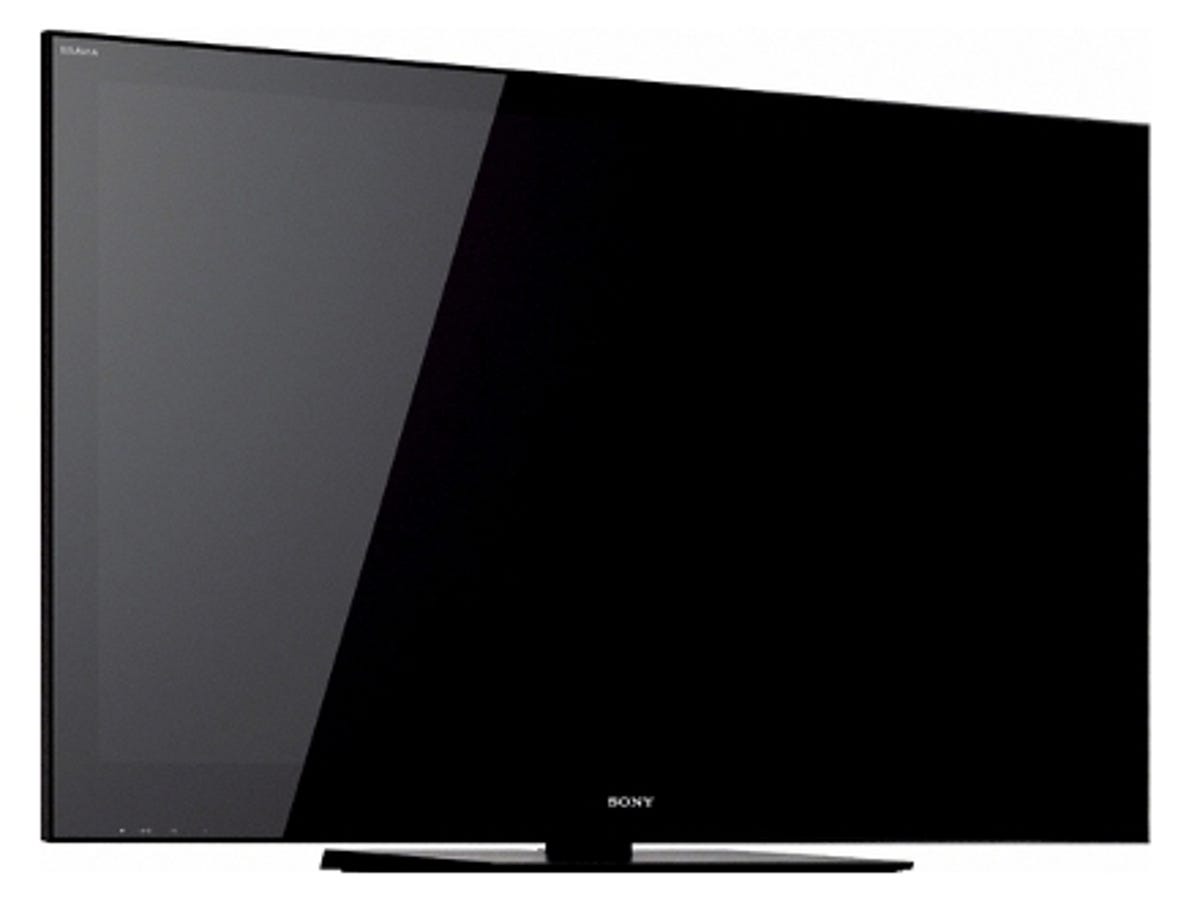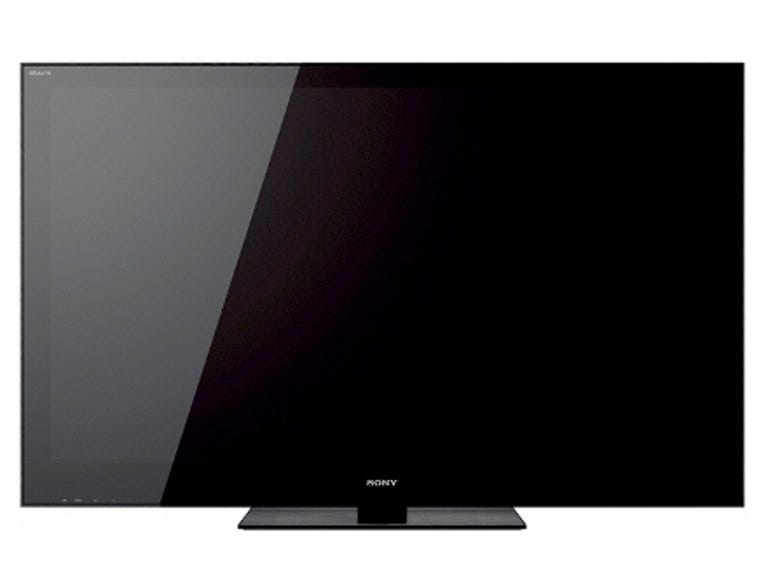 Why You Can Trust CNET
Why You Can Trust CNET Sony Bravia HX903 (KDL-46HX903) review: Sony Bravia HX903 (KDL-46HX903)
The 46-inch, 1080p, LED-backlit KDL-46HX903 LCD TV is a stylish behemoth. You'll need to purchase an add-on pack to exploit its 3D capability, which is cheeky, given the set's price, but this telly looks great and its online video functionality is cracking
Sony has been at the forefront of pushing 3D uptake in both cinemas and the home. The reason for this is simple: it has a massive investment in both a major movie studio and consumer electronics. If everyone upgrades to 3D, Sony stands to rake it in. Even so, Sony wasn't the first company to put a 3D telly on the UK market -- we saw models from Samsung and Panasonic before the 46-inch, 1080p Bravia KDL-46HX903 LCD TV.
The Good
The Bad
The Bottom Line
Still, as people who post comments on the Internet all too frequently prove, being first doesn't always mean you've got anything useful to say. So let's see what the LED-backlit KDL-46HX903 is made of. It's available now for around £2,500.
Update: Now that Sony's provided us with the 3D add-on kit, we've updated this review to take into account the TV's 3D performance. The score is unchanged.
Gives you a hernia
The KDL-46HX903 has what Sony calls a 'monolithic design', with an enormous glass panel adorning its front. It's heavy enough to cause several hernias if you pick it up. As stylish as this TV looks, and as helpful as glass can be for increasing contrast performance, we really don't understand why Sony couldn't have used a lighter material.
But this TV does look cool, even when it's turned off. In fact, it looks cooler when it's off than when it's on. Combine this appearance with an LED backlight and a decent selection of inputs for your video equipment, and you have yourself a well-designed TV.
We also love the remote control, although it is quite large. The curved surface is aesthetically pleasing, and there's a good selection of genuinely useful buttons to be found on its surface.
Internet content aplenty
Sony excels in its provision of Internet video services. All of its high-end TVs now feature the Bravia Internet Video service, which allows you to watch movies via LoveFilm, catch-up TV from the likes of the BBC and Five, and short videos from Dailymotion and YouTube.
We like this feature a great deal, and Sony has gone out of its way to make its service as useful and user-friendly as possible. The quality of streaming video from these services varies wildly, and none are high-definition. In particular, LoveFilm looks rather ropey. That's not Sony's fault, though, and we're really happy that it's providing such a good selection of services, with more promised.
3D ready, sort of
This TV is ready for the 3D revolution, but not out of the box. To tease 3D video out of it, you must first purchase an add-on pack, including spectacles and a 3D transmitter that attaches to the screen and synchronises the glasses with the alternating on-screen frames. Considering the price of this TV, not having built-in 3D capability is something of a cheek. After all, Panasonic's 50-inch Viera TX-P50VT20B plasma TV costs roughly the same amount, and does include everything you need to immediately float your 3D boat.

We're told that it's possible to get a 3D pack with a sync transmitter and two sets of glasses for a reduced price. Separately, the transmitter costs around £50, and the glasses are £100 each. However you look at it, spending £2,500 on a TV and then having to purchase glasses for the whole family, as well as a transmitter, is a galling prospect.
Sony's 3D glasses are quite comfortable. They aren't as pleasant to wear as Samsung's (our favourite specs so far) but they comprehensively beat Panasonic's offerings. They also feel like the sturdiest glasses we've seen so far. After we wrecked a pair of flimsy Samsung ones, that's good news.
Setting up the TV for 3D
Once you've got the 3D add-on pack, setting the TV up is a doddle. Plug in the sync transmitter, and the TV automatically detects that you can now see 3D content. Upon receiving a 3D signal, it switches into 3D mode. The glasses will also turn themselves on when the transmitter fires up, so, assuming you have HDMI-1.4a-certified hardware, you shouldn't have to do anything to see 3D material.
3D pictures
There's much to like about the 3D portion of this TV. Firstly, this telly scores one over the Samsung UE55C8000 that we reviewed recently by not exhibiting any significant ghosting. Ghosting occurs when a 3D TV doesn't have a sufficiently fast response time, with the result that you can see with your left eye, for example, traces of a frame intended for the right eye.
The KDL-46HX903 also beats Panasonic's 3D offering in terms of brightness. Plasma technology isn't especially well suited to producing super-bright images, and that can be a problem, since 3D glasses reduce the amount of light that reaches your eye. A 3D image really needs to be bright to work well, and Sony's set certainly wins in this regard.
Nevertheless, we still found the Panasonic TV's 3D images to be the easiest to watch, even if the overall effect isn't quite as powerful as that of Samsung and Sony's sets. The KDL-46HX903's 3D effects are still good though, and it's a very capable 3D TV. One word of advice: watch 3D movies in the dark, because reflections on the all-glass screen can be a real issue.
Standard-def images
We've come to terms with the fact that Freeview has turned into a mess of noise and blockiness as TV companies squeeze more and more channels into a tiny space. A good TV can clean the image up slightly, though, and the KDL-46HX903 does a pretty decent job in this regard. Give it a better source, like a DVD, and it proves itself an even more capable TV.
Freeview HD and Blu-ray quality
High-definition Freeview material, like BBC HD and 4HD, looked good but not exceptional on the KDL-46HX903. The bit rates for Freeview HD channels will never be completely satisfactory, so this isn't entirely Sony's fault. We've seen TVs handle the service better, though, and we found the overall image to be quite soft.
Similarly, with Blu-rays, we noticed a reasonable, but not exceptional, amount of detail in images. Casino Royale looked pleasant enough, but it was by no means pin-sharp, and neither was District 9.
The KDL-46HX903 includes Sony's Motionflow 400 Pro system. This aims to produce the best-possible picture and reduce blurring on moving images. We opted to turn the judder-reduction modes off, though, as we prefer the 'film look'. The TV did a good job of maintaining picture detail during panning shots, which is a definite plus.
LED backlighting doesn't beat plasma
LCD TVs have an Achilles heel that doesn't affect plasma TVs -- black levels. On an LCD TV, they can often look grey and unpleasant. Sony has used a 'full LED' backlight on the KDL-46HX903, which means it has plenty of control over light, and can dim certain areas of the display to increase contrast in black or dark areas.
We had no complaints with the black levels when watching TV, but we noticed that the LED illumination was visible when a static black screen was displayed. We also noticed that moving our head would change the intensity of this light. But we had no problems with changing light levels when watching moving pictures, which is good news.
It's safe to assume that one of the big factors in this TV's cost is the LED backlight. LED backlights may be expensive but they offer a distinct advantage over cheaper LED edge lights, as they don't cause bright spots at the edges of the screen. That means you get a much more uniform picture, and no odd colour or brightness issues.
Sounds different
Unlike most TVs, the KDL-46HX903 offers pretty reasonable audio. It's clear and crisp, and we found dialogue very easy to understand. Overall, it's a welcome change from the rubbish sound quality we usually get.
The TV can optionally be attached to an aluminium stand that carries the sound from the downward-firing speakers out towards the viewer. Sony didn't provide one for us to test, however, so we can't tell you if it affects the audio in any way.
Conclusion
The Sony Bravia KDL-46HX903 is expensive, yet doesn't come with everything you need to start watching in 3D. Consequently, we don't know why you'd pick this TV over Panasonic's 3D model, which is 3D-capable out of the box. It doesn't even include built-in Wi-Fi for accessing Sony's excellent Bravia Internet Video service. We could forgive that in an £800 TV, but not in one that costs £2,500.
The 3D effect is very good, but the TV is still overpriced in comparison with the 55-inch Samsung UE55C8000, or the 50-inch Panasonic Viera TX-P50VT20B. The KDL-46HX903 only offers a 46-inch screen, and size matters when it comes to 3D content, with smaller screens not producing as involving an effect. When you factor in the cost of the 3D pack and Blu-ray player you'll need to buy, the set begins to look even more extraordinarily expensive.
It also seems reasonable to point out that this TV costs more than a 50-inch Pioneer Kuro PDP-LX5090 did a couple of years back. That TV offers better picture quality than the KDL-46HX903 too.
Overall, the KDL-46HX903 is good, but not exceptional, which makes it hard to recommend at its current price.
Edited by Charles Kloet
